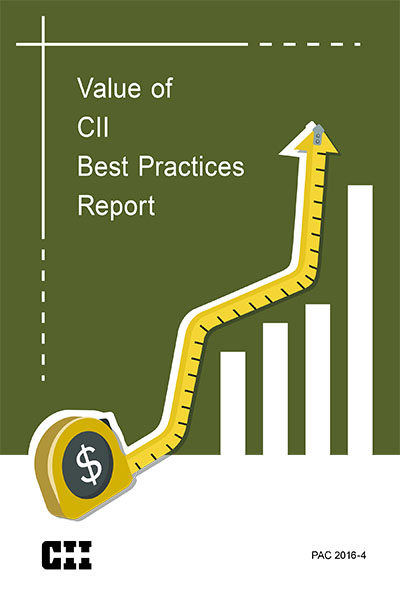
CII Value of Best Practices Report
Since the establishment of the Construction Industry Institute (CII) in 1983, its industry members and academic researchers have collaborated on research to improve the cost effectiveness of capital project delivery. CII research on the industry’s processes and methods has generated 14 best practices, many of which have been adopted by the industry at large. The CII Best Practices are defined as “process[es] or method[s] that, when executed effectively, [lead] to enhanced project performance.” To qualify as a CII Best Practice, a practice must be sufficiently proven through extensive industry use and/or validation. The 14 CII Best Practices are as follows:
- Alignment
- Benchmarking and Metrics
- Change Management
- Constructability
- Disputes Prevention & Resolution
- Front End Planning
- Implementation of CII Research
- Lessons Learned
- Materials Management
- Partnering
- Planning for Start-up
- Quality Management
- Team Building
- Zero Accidents Techniques.
The last time the CII Benchmarking & Metrics Committee performed a comprehensive assessment of the CII Best Practices, it culminated in the 2003 Value of Best Practices (VBP) Report. The results of the 2003 study only addressed the value of eight of the CII Best Practices. This was mainly due to insufficient data submitted regarding actual implementation of the practices. Further, while most respondents agreed that individual practices were valuable, assessing the impact of using multiple practices within the project environment has been limited to date. With these issues in mind, CII decided to launch a new member-wide data collection effort in order to form the basis for new analyses. In 2007, the Benchmarking & Metrics Committee formed a CII Value of Best Practices team to craft a new survey to better assess the value of best practices by incorporating lessons learned from earlier benchmarking efforts.
Figure 10 illustrates how well the best practices were implemented by the owners and contractors.
{^widget|(widget_displayname)WatermarkImage|(name)WatermarkImage|(image)%7e%2fCII%2fmedia%2fPublications%2fBMM2010_4Figure10.PNG%3fext%3d.png|(width)|(height)^}
Figure 12 presents the percentage of projects that scored a high level of use for each best practice. The numbers next to each best practice represent the sample size. The score ranges from 0 to 10, with 0 indicating no use of the best practice and 10 indicating full implementation. In Figure 12, a VBP score greater than or equal to 6.67 is considered “high use” or “well implemented.” By using this definition for “high use,” the team found Change Management, Zero Accidents Techniques, Planning for Start-up, and Front End Planning to be the four best practices that were well implemented. Figure 12 shows the percentage of projects implementing each best practice at a high level.
{^widget|(widget_displayname)WatermarkImage|(name)WatermarkImage|(image)%7e%2fCII%2fmedia%2fPublications%2fBMM2010_4Figure12.PNG%3fext%3d.png|(width)|(height)^}
(See Table 1.) In general, projects submitted by organizations with good improvement cultures tend to implement best practices at higher levels than do projects submitted by organizations without strong improvement cultures. The average project cost growth decreased from 6.3 percent to –1.2 percent for the projects using Planning best practices at the fourth quartile level and the first-quartile level, respectively.
{^widget|(widget_displayname)WatermarkImage|(name)WatermarkImage|(image)%7e%2fCII%2fmedia%2fPublications%2fBMM2010_4Table1.PNG%3fext%3d.png|(width)|(height)^}
The use of best practices also indicates a significant difference on project schedule growth The projects with a high Best Practice Index (i.e., projects in the first quartile of best practice use) had an average schedule growth of 1.8 percent. In contrast, projects with a low Best Practice Index on average had 11.5-percent schedule growth.
For contractor-submitted projects a significant impact was observed regarding Execution best practices. As can be seen in Figure 18, the projects with a high Execution best practice score achieved an average cost growth of –3.0 percent, whereas the projects with a low Execution best practice score had an average cost growth of 9.2 percent.
{^widget|(widget_displayname)WatermarkImage|(name)WatermarkImage|(image)%7e%2fCII%2fmedia%2fPublications%2fBMM2010_4Figure18.PNG%3fext%3d.png|(width)|(height)^}


